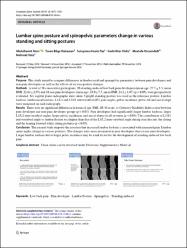Lumbar spine posture and spinopelvic parameters change in various standing and sitting postures

View/
Access
info:eu-repo/semantics/closedAccessDate
2019Author
Misir, AbdulhamitKizkapan, Turan Bilge
Tas, Suleyman Kasim
Yildiz, Kadir Ilker
Ozcamdalli, Mustafa
Yetis, Mehmet
Metadata
Show full item recordAbstract
PurposeThis study aimed to compare differences in lumbosacral and spinopelvic parameters between pain developers and non-pain developers as well as the effects of various posture changes. MethodsA total of 38 consecutive participants, 20 standing-induced low back pain developers (mean age: 27.75.3; mean BMI: 22.642.95) and 18 non-pain developers (mean age: 29.07.5; mean BMI: 24.2 +/- 1.87) (p>0.05), were prospectively evaluated. Six sagittal plane radiographs were taken. Upright standing posture was used as the reference posture. Lumbar lordosis, lumbosacral lordosis, L1/L2 and L5/S1 intervertebral (IV) joint angles, pelvic incidence, pelvic tilt and sacral slope were measured on each radiograph. Results p id=Par3 There were no significant differences in terms of age, BMI, SF-36 score, or Oswestry Disability Index scores between pain developer and non-pain developer groups (p>0.05). Pain developers had significantly larger lumbar lordosis, larger L1/L2 intervertebral angles, larger pelvic incidences and sacral slopes in all postures (p<0.05). The contribution of L5/S1 intervertebral angle to lumbar flexion was higher than that of the L1/L2 intervertebral angle during stair descent, the sitting and the leaning forward while sitting postures (p<0.05). Conclusion p id=Par4 The current study supports the assertion that increased lumbar lordosis is associated with increased pain. Lumbar spine angles change in various postures. The changes were more prominent in pain developers than in non-pain developers. Larger lumbar lordosis due to larger pelvic incidence may be a risk factor for the development of standing-induced low back pain. [GRAPHICS] .

















